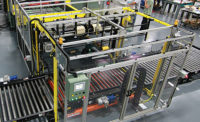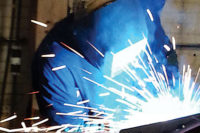Every builder of automated assembly systems talks about flexibility and simultaneous engineering, but how are these concepts put into practice in real-world projects? For a medical device company, an automotive company and a telecommunications company, these simple concepts produced major results.
Philips Speaker Systems
One of the world?s leading suppliers of mobile telephones wanted to introduce a new miniature loudspeaker with a diameter of only 13 millimeters. The company entrusted the development and manufacture of the loudspeaker to Philips Speaker Systems (Vienna, Austria).In the mobile telephone market, the ability to introduce a new product in the shortest possible time and in large numbers is critical. Philips needed to bring the loudspeaker from prototype to high-volume production within 6 months. The huge rotary assembly machines Philips previously used to assemble loudspeakers were not appropriate for the new model. Even in the commissioning phase, it?s only possible to operate the machines sequentially, station by station.
After evaluating several assembly system designs and suppliers, Philips opted for Mikron?s Flexifactor assembly system. Thanks to simultaneous engineering, the strict delivery dates for supplying the first series of speakers were successfully met.
Developing the assembly system for Philips represented a genuine challenge to Mikron?s project engineers. Philips? specifications required that some critical assembly operations had to be performed to accuracies of 0.01 millimeter. For example, these tolerances were required for positioning a 28-micron copper wire and for positioning a diaphragm with a controlled quantity of bonding agent.
Five factors were critical to the success of the simultaneous engineering on this project.
Modular system structure. Certain assembly tasks required specific process expertise that only Philips? engineers knew. Automating these tasks had to be kept in-house. Thanks to the modular nature of the Flexifactor system, the first cell of the assembly linein which most of these critical operations are carried outwas delivered after only 3 months. This allowed Philips? specialists to fine-tune their proprietary processing stations. The rest of the system was produced in parallel at Mikron. Standardized interfaces ensured that assembling and commissioning the complete system at the Philips site was problem-free.
Project management. The project began with a kickoff meeting at the customer?s plant. During the project, work proceeded according to a detailed timetable with specified milestones. In such strategically significant projects, it?s important to assign responsibility for project management to an overall steering committee composed of senior management from both the customer and the supplier. In critical situations, this committee can change priorities at the highest level.
Optimized flow of information. A firmly specified schedule of meetings, including internal biweekly team meetings and monthly project discussions with the customer, proved successful. In addition, ad hoc project meetings were called when fundamental changes needed to be made.
Engineering and communication tools. E-mail proved to be the most efficient means of communication between Philips and Mikron, particularly for distributing drawings, tables and other data to team members. To reduce traveling to a tolerable level, Mikron employed video conferencing for short ad hoc discussions. Visits in both directions were not eliminated entirely. Important project discussions always took place in person.
Rigorous project control. At every stage of the project, Mikron used a method that has been employed successfully for many years: actual vs. target comparisons with respect to progress, quality and project costs. This management tool keeps the processes under control and guarantees the customer a strictly managed project, including compliance with delivery dates and performance criteria.
"Our telecommunication industry contracts for the precision assembly of micro-loudspeakers for mobile telephones...are due in no small measure to the rapid time-to-volume made possible by the Mikron automation system," says Friedrich Barisits, senior project manager at Philips Speaker Systems. "This system integrates all the essential technological and technical processes, such as the extraordinarily rapid positioning and soldering of the 28-micron copper wire."
TRW Air Bag Systems
An air bag must function under all circumstances, and it must be inflated taut within a few milliseconds. Heat, cold, vibration, moisture, electromagnetic fields¿nothing must impair the air bag?s functionality. In the end, human life is at stake. The assembly of gas generators for air bags therefore demands the highest level of reliability and process stability¿zero defects in 100 percent of the items.This was the challenge faced by automotive supplier TRW when it came time to assemble its most recent development: a pyrotechnic inflator for passenger air bags, or PPI3.
Until recently, automakers had preferred air bag inflators with hybrid gas generators, which used both chemical and pyrotechnic means to inflate the air bag. Now, however, automakers are returning to air bags that rely strictly on pyrotechnology. The reasons for this are controllability of the ignition procedure, process reliability and the ability to produce multistage gas generators simply. In fact, the principal appeal of TRW?s new PPI3 air bag inflator is the possibility of achieving an almost unlimited chamber distribution between the primary and secondary ignition.
TRW chose Mikron?s Flexifactor high-speed assembly system to build the new inflator. This was not a difficult decision. TRW was already using seven Flexifactor systems and 25 Flexcell assembly cells to assemble gas generators for other air bag models throughout its factories in Germany and the United States.
From the outset, the assembly line for the PPI3 was planned with simultaneous engineering. To get the new air bag to market quickly, the assembly line was designed and built in parallel with development of the gas generator. Specialists from development, engineering, control systems, work planning, purchasing and final assembly were employed on the project, under the leadership of a project manager. The team worked according to a plan that specified everyone?s tasks and responsibilities. This resulted in rapid process Arial and fast delivery.
Because air bag inflators cannot be functionally tested at the conclusion of assemblythis would produce 100 percent scrapMikron and TRW planned the line so that any deviations from the required condition are identified after each assembly step. Each inspection is conducted and documented on-line without removing components from the system. In some cases, this meant that Mikron and TRW had to develop their own laser welding monitors, image recognition systems, leak testers, weight and force measuring devices, and resistance inspection equipment.
The inflator is assembled in a series of autonomous assembly cells. The cells are connected by a conveyor for free-running workpiece carriers. The parts to be assembled are transferred by the carriers from one cell to the next. Within the cells, the carriers are moved along by a cam-operated walking-beam. The beam controls acceleration and deceleration to ensure a jolt-free index at very short cycle Arial. At the end of the cell, the carriers are pushed onto the conveyor for transport to the next cell.
The gas generators require some highly complex assembly processes. Mikron developed laser welding cells specifically for this project. The cells must produce airtight welds of the prepressed disks needed to separate the chambers of the generators. Five welding cells are alternately actuated by two powerful laser units.
The performance of an air bag can be substantially influenced by the composition and the amount of the fuel in the generator. For this reason, the assembly system does more than just measure the quantity of fuel dispensed into each generator. The complete gas generator is also weighed before and after filling. The resulting weight is electronically stored, and the exact quantity inside each chamber is determined independently.
All the data for each part must be stored for at least 15 years. This documentation takes place by means of three control hierarchiesplant control, group control with a safety PC, and master computer. All the workpiece carriers are equipped with data carriers for data transfer within the system. The information for each part is supplied to the generator through bar code labels and permanent laser marking. In parallel with this, all the data is passed to the master computer for archiving.
Flexibility was a key performance requirement of the assembly system. Many different gas generators are assembled by the same system. TRW makes gas generators for driver, passenger and side-impact air bags for a variety of automakers worldwide. The air bags range in size from 8 to 160 liters. To handle this challenge, the assembly systems were designed to minimize setup complexity, and thus minimize lost productivity.
"Mikron fulfilled our expectations in every respect," says Richard Stanzel, plant manager for TRW Airbag Systems GmbH & Co. "Program dates were invariably met. And just a few days after commissioning, the plant achieved the planned production capacitythanks to their tested and proven technology."
Aventis Pharma
When Aventis Pharma Deutschland GmbH Pharmaceutical Manufacturing Div. (Frankfurt, Germany) developed a novel, disposable insulin injector, it had to start from scratch in dealing with its assembly.The pen-style injector mechanism is assembled by a subcontractor using Mikron¿s Flexifactor high-speed assembly system. Assured by the contractor¿s experience with the system, Aventis chose Mikron to develop a fully automatic system for final assembly and inspection of the entire injector.
For Aventis, an essential aspect of the assembly system was flexibility. The system would not only have to manufacture batches of 10,000 or more injectors in a highly productive manner, it would also have to adapt quickly if changes in the product were necessary.
Mikron¿s Syfast robotic assembly cells met both requirements. The system can assemble 220 parts per minute. And, since the beginning of 2000, 16 different parts have been manufactured on the system.
The system comprises four robotic cells; a process cell; two palletizing units; a labeling and supply system for ampoules; a supply system for protective caps; and two mills with a central withdrawal unit for destroying trays.
The first robotic cell supplies the sleeves and orients them in the workpiece carrier nests. The second cell supplies the ampoules and presses them into the sleeves. The third cell supplies the injector mechanism, orienting it and pressing it into the sleeves. Force and displacement monitoring are used throughout this process to ensure quality. The fourth cell supplies and fits the protective cap.
Several quality inspections are performed after each step, including a final acceptance inspection at the packaging unit. Faulty parts and assemblies are routed to a separate machine.
"Quality has top priority in the assembly of insulin pen injectors, but the necessary rate of production must still be achieved, day in, day out," says Berthold Roth, engineering technology manager at Aventis Pharma Deutschland GmbH Pharmaceutical Manufacturing Div. "These two requirements are ideally met by the Flexifactor high-speed system for assembling the pen injector mechanism and the Syfast robotic assembly system for the final assembly. With this configuration, we can achieve a production rate of tens of thousands of pen injectors every day."
For more information about automated assembly systems, call Mikron Corp. Denver at 303-364-5222 or visit www.mikron-tg.com.

